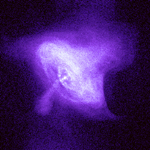The Crab Nebula is the remnant of a star that was observed to explode in 1054 A.D. It is located 6,000 light years away in the constellation of Taurus, and is a strong source from radio through gamma ray wavelengths. The center of the remnant contains a rapidly rotating neutron star– or pulsar– that is apparently pumping enormous amounts of energy into the nebula in the form of high-energy particles and magnetic fields. Chandra's X-ray image provides significant clues to the workings of this mighty cosmic "generator," which is producing energy at the rate of 100,000 suns. The dramatic tilted rings that span the distance of a light year appear to have been flung outward from the pulsar. Perpendicular to the rings, jet-like structures produced by high-energy particles blast away from the pulsar.
The Crab Nebula Neutron Star – A Cosmic Generator A neutron star is formed by the extreme conditions created in a supernova. When a massive star explodes, most of the star is flung into space, but the core of the star is compressed to form a rapidly rotating—30 times per second for the Crab—dense ball of neutrons that is twelve miles in diameter. The collapse and rapid rotation of the neutron star cause it to become highly magnetized. A magnetized, rapidly rotating neutron star such as the Crab pulsar can produce electric voltages of ten quadrillion volts.
Neutron star gravity, which is more than a hundred billion times stronger than gravity on Earth, is overwhelmed by the electric field and particles are pulled off the neutron star and accelerated to speeds near the speed of light. A blizzard of electrons and anti-matter electrons, or positrons, is produced by these particles. The pulsed emission from the Crab Nebula, observed at all wavelengths from radio through gamma rays, is thought to be caused by this process.
As particles stream out from the pulsar and spiral around magnetic field lines, they produce a distinctive kind of radiation known as synchrotron radiation. The Crab Nebula's bell-shaped appearance in the X-ray image is due to synchrotron radiation from a huge magnetized bubble of high-energy electrons that is several light years in diameter.
The Neutron Star – Nebula Connection How the pulsar's power gets into the Crab Nebula has long puzzled astronomers. Chandra's image of the Crab Nebula provides an important new piece of evidence. With Chandra's fine resolution (less than an arc second), an X-ray jet can be traced all the way in to the neutron star, and an inner ring is seen for the first time. This ring is thought to represent a shock wave due to matter rushing away from the neutron star. A similar, but more focused, flow at the neutron star's polar region produces a jet of particles that blasts away at near the speed of light.
[ Press Index ] [ Fact Sheets ]


